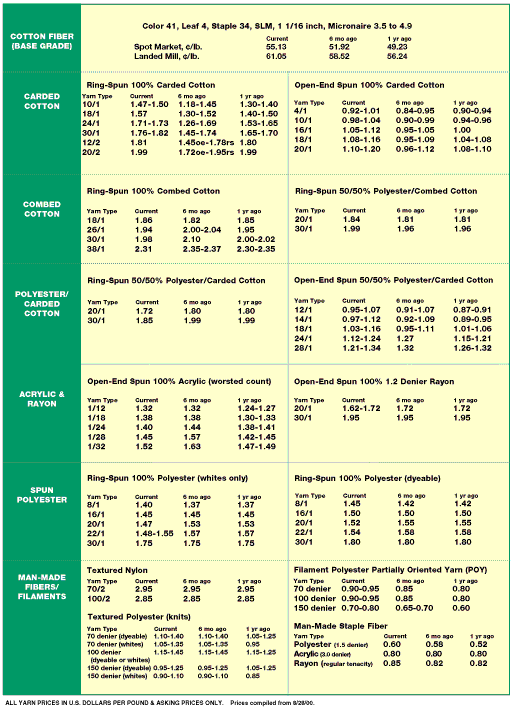T
ere continues to be little rhyme or reason for the conditions in pricing of open-end (OE)
yarns. One OE spinner said, “We have orders to keep us running and we are shipping everything we
make, but there are no margins to speak of. Our contracts are locked in for the rest of the year,
but next year is going to be interesting! The industry as a whole is going to have to start quoting
higher prices — not a lot but a legitimate increase just so we can make a little money. One of my
customers told me that he wouldn’t mind paying $1.50 per pound for a good l0/1 yarn — as long as
everybody else was paying about that same price.”
Just after he remarked about the possibility of higher prices next year, he was reminded
that he had been saying that for several years. His comment: “Well, we have to have a positive
attitude about it. But it appears to me that open-end spinners are afraid of losing a pound of
business, so they quote these ridiculous prices. One spinner told me that he had heard of an 18/1
OE cotton yarn sold as a circular-knit yarn for 89 cents a pound plus — now get this — plus the
cotton rebate.
When something as illogical as this is done, you wonder if they ever look at a cost sheet.
Has this crowd learned their lesson yet?” The consensus was — No. He also mentioned that another
factor in the pricing problem is the problem his customers are having with credit. They are
apparently filing for Chapter 11 in increasing numbers.
OE Markets Go Crazy
Several spinners classified the OE market as “crazy.” One spinner said, after quoting asking
prices for this type yarn, “You could probably go out and buy a 16/1 cotton yarn for 90 cents a
pound. We are running full, but at the end of the week, you ask yourself ‘was it worth it?’” The
consensus here, too, was — No!
Another said, “All markets are generally slow, especially those in knitted outerwear and
domestic and home furnishing weaver’s fabrics. We attribute this to an inventory adjustment and
expect an up-turn soon. Retail sales have been disappointing this past summer. All summer business
is slow, but this one has been especially bad, particularly in open-end yarn.”
Brighter Notes
Looking on the brighter side, the Yarn Market finds spinners of ring-spun yarns continue
having their place in the sun. All of their markets are “great — wide open.” Not only are the
orders coming in, but orders are backlogged. Ring-spun inventories are non-existent. One spinner
commented, “We can’t afford an inventory because we are running so far behind. The biggest catalyst
to this was the increase in denim orders.” In other words — denim is back.
There is more good news. One respondent said, “We are finally beginning to see some
reconciliation to the over-supply of open-end yarn. We are taking some OE yarn machines out, and
other spinners are taking out the older, more expensive-to-operate machines as well.” So maybe
spinners will finally see some relief from the pricing dilemma they have complained about for
years.
One spinner commented that he had already picked up some small orders related to the
Caribbean Basin Initiative (CBI). He also sees this as a continuing trend. His optimism is shared
by many in this diversified industry — from synthetic spinners to texturizers, including yet
another spinner who said, “We have had a few orders for this business, but we are fielding a lot of
inquiries concerning CBI yarn business. This area is very active! We are also exporting to Mexico
and the growth here, while not as dramatic as it was initially, continues at a slower rate. Of
course, our exports are offset to some extent by imports from Mexico.”
Texturizers are sounding more like OE cotton yarn spinners every day — volume is good across
the board, but margins are poor. “We are really wrestling with pricing,” commented one texturizer,
“and our biggest problem is with imports.” Although overall volume is good, there is concern about
bottom-weight apparel goods. Orders seem to be dropping off, and a down-turn is expected in the
fourth quarter.
The volume of inquiries from CBI areas is an indicator that help is on the way to
beleaguered spinners.
As the fellow on the Murphy Brown show might say “Alls I know, you just have to keep on
keeping on.”
October 2000





